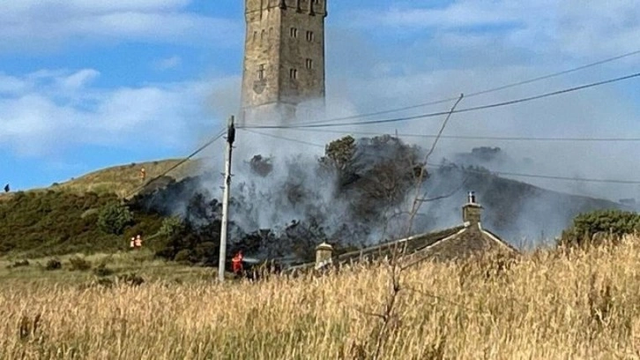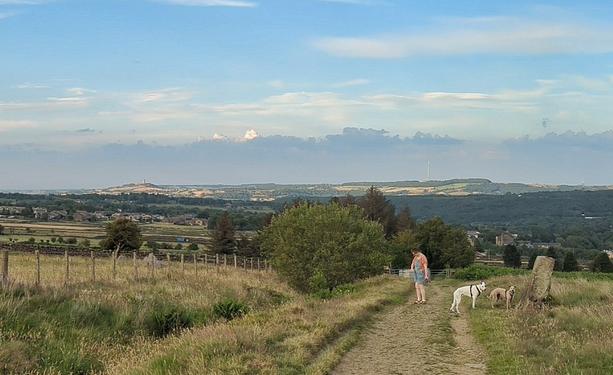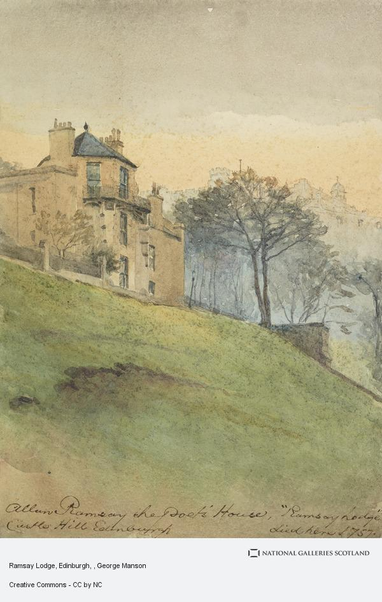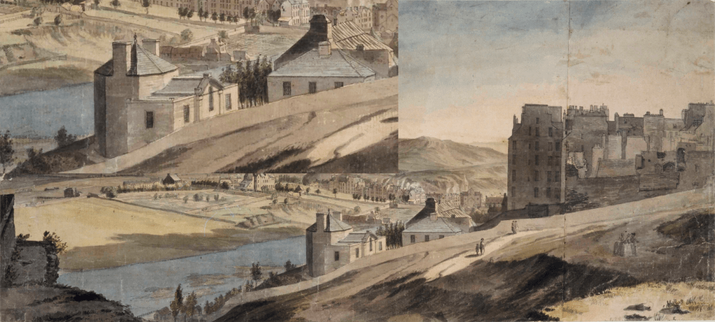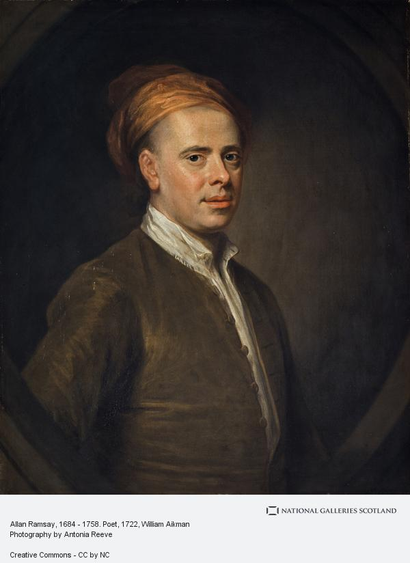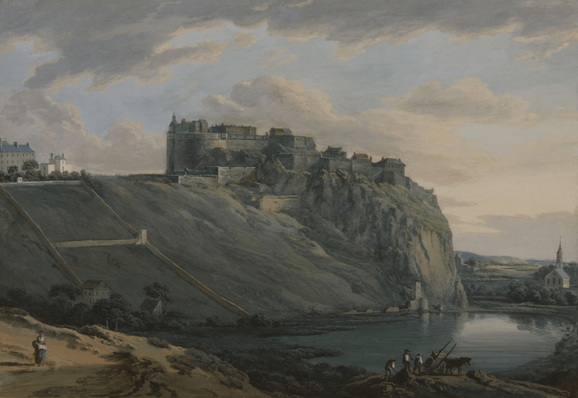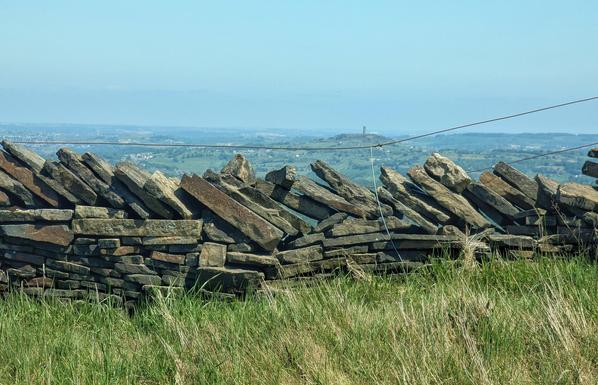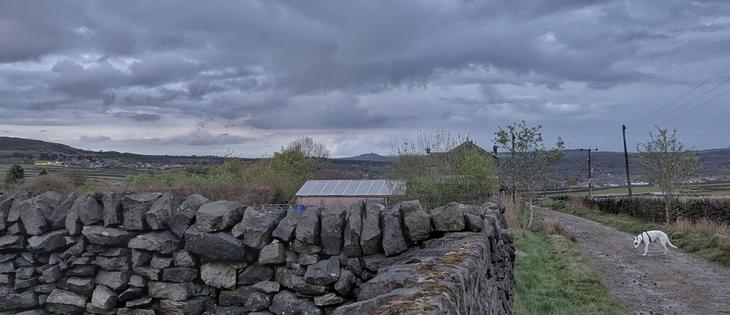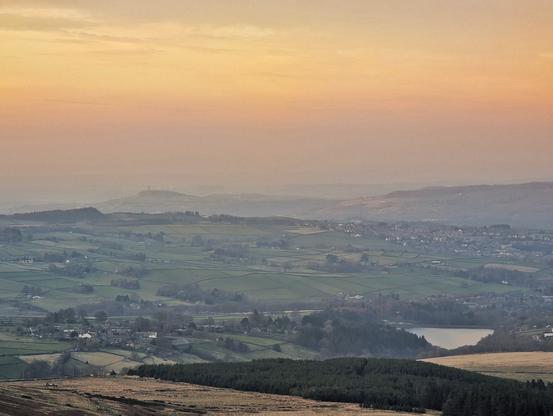İngiltere'de Castle Hill Tepesi’nde yangın: İngiltere’nin kuzeyindeki Huddersfield kentinde bulunan tarihi ve simgesel Castle Hill Tepesi’nde çıkan ot yangını, itfaiye ekiplerince kontrol altına alınmaya çalışılıyor. West Yorkshire İtfaiye ve Kurtarma Servisinden yapılan açıklamada, dün öğleden sonra Castle Hill'in eteklerinde başlayan ve kısa sürede yayılan yangına 6 itfaiye aracının… https://www.eshahaber.com.tr/haber/ingiltere-de-castle-hill-tepesi-nde-yangin-239300.html?utm_source=dlvr.it&utm_medium=mastodon EshaHaber.com.tr #CastleHill #Huddersfield #yangın #itfaiye #yangınkontrolü
#CastleHill
#CastleHill on this evening's #dogwalk
The thread about the Guse Pye; house of a poet and a painter that’s still there if you know where to look
There is a stunning watercolour landscape painting of Edinburgh in the mid-18th century, observed from the point of view of the Castle looking north to Leith by Paul Sandby (there’s a whole thread on that if you click the link). In the mid-ground of that picture is a prominent and intriguing building: a tall octagonal structure with a wing and portico to its front. This building was Ramsay Lodge or Ramsay Hut, the home of the romantic poet and stalwart figure of the Edinburgh enlightenment, Allan Ramsay.
“Edinburgh & the North Lock with the Bank on Which the New Town is Built” By Paul Sandby, c. 1750. Showing inset an enlargement of the prominent house in the mid-ground. Maps K.Top.50.96.b, British Library, PD.During his 4 years in Edinburgh, the young Paul Sandby – a military draughtsman engaged in assisting William Roy with his “Great Map” of North Britain – had become well acquainted with Allan Ramsay and a welcome addition to the social circle that redeveloped around him. It is therefore not surprising that his house features so prominently in this and another landscape painting by Sandby.
Ramsay was born in Leadhills, Lanarkshire, the son of the superintendent of the lead mines that gave the settlement its name. As a boy, he was apprenticed to a wigmaker in Edinburgh and it was in this trade that he would first find success, both financial and professional. A man of broad interests and intelligence, in 1720 he entered the book selling trade from his shop on Niddrie’s Wynd and in 1722 he relocated himself and the business to the Luckenbooths – 18th century Edinburgh’s premier retail space. It was from the first floor here,in 1725, that he opened Scotland’s first circulating library. This establishment had over 30,000 titles available to borrow and it became the hangout for city’s literati.
Allan Ramsay the Poet (1684 – 1758), by William Aikman. This painting belonged to Ramsay’s correspondent and patron, Sir John Clerk of Penicuik. Aikman was a friend of both men. CC-by-NC National Galleries ScotlandAs well as a businessman, Ramsay was something of a wit and a writer, and published his own work. His romantic poetry, exemplified by The Gentle Shepherd brought him critical acclaim and he found himself desiring a “poet’s nest” as befitting a bard of his standing. What he needed was a suburban retreat, at once in the heart of the city’s bustling Old Town but at the same time outwith its confines. He found this such a spot on the northern slopes of the Castle Hill, commanding views over the fields: past the smoky smudge on the shoreline of Leith and across the Forth and Fife beyond to the Highland mountains in the distance.
“Edinburgh Castle” by Paul Sandby, with the Guse Pye house bright and prominent on the Castle Hill. The West Kirk (St. Cuthbert’s) is the church at the head of the Nor Loch on the right. CC-by-NC-ND 3.0 Tate GalleryIn September 1733, Ramsay acquired a portion of garden land at this location from Robert Hope, a surgeon. In Memorials of Edinburgh, a story is related that he desired “as much land as he could get” to build a “cage for his burd” (i.e. his wife, of whom he was fond) and that this was the reason for its unusual, tall, octagonal structure. From an architectural point of view, it is thought the house may be inspired either by the Tower of the Winds in Athens or the 1720 Octagon Room of Orleans House in Twickenham by Scottish architect James Gibb for James Johnston, a former Secretary of State for Scotland.
View of the Tower of the Winds, Athens, Rey Etienne, 1867 (PD)The Octagon Room, Orleans House. CC-by 2.0 Matt BrownRamsay wanted the whole town to admire his mansion but the wags of the city derided his hubris and called his octagonal house the Guse Pye, after the shape of the traditional Scottish Christmas dish. Ramsay’s pride was hurt and he complained to Patrick Murray, 5th Lord Elibank, who retorted “Indeed, Allan, when I see you in it, I think the wags are not far wrong“. The ownership of the house was transferred to his son, also Allan Ramsay, in 1741. This Allan Ramsay is as famous as his father, but as a portrait painter, and he had designs on using the building as his studio (although he would spend most of his time away from his native City).
Allan Ramsay the Painter (1713 – 1784), copy of a self-portrait by Alexander Nasmyth. CC-by-NC National Galleries ScotlandIn 1742, Ramsay the Poet retired to his Guse Pye, shutting up his house and bookshop in the Luckenbooths. He intended to spend what would be the final 12 years of his life in “ease and tranquil enjoyment” however his burd, Christian Ross, died the following year. He was not alone in life however, as his company was courted by all ranks of Edinburgh, who sought him out at the Guse Pye. It is said that he preferred instead to be surrounded by his family and their young friends, joining in their fun and games with “hearty life and good humour“. These young friends included the Paul Sandby also painted a very intimate sketch of Ramsay smoking an enormous “Churchwarden’s Pipe” in the house. Surrounded by two young women; with a book on his table; a cup by his side to drink from and a candle burning on the wall, it is a very homely scene. Ramsay was a bit of a closet Anglophile at heart, desiring to be an equal with the London literary wits, and this talented young Englishman would have been a fine addition to his circle.
Alan Ramsay the Poet, in later life by Paul Sandby, c. 1750 RCIN 914403 © Royal Collection TrustWhen the Jacobites routed the Hanoverian Army under Sir John Cope at Prestonpans in September 1745, Ramsay the Poet – despite his known Jacobite sympathies (or perhaps because of them) – retired a safe distance to Mavisbank in Midlothian, the home of his correspondent and friend Sir John Clerk of Penicuik, 2nd Baronet. The Highland army of Charles Edward Stuart soon occupied the city, without resistance, where Ramsay the Painter, happened to be present on one of his infrequent sojourns north. Word was soon sent to him from the Palace of Holyroodhouse, desiring him to come at once and paint a picture of the Prince who hoped to be his King: which he did.
Prince Charles Edward Stuart, Allan Ramsay, 1745During this period, the Guse Pye found itself damaged by the cannons of Edinburgh Castle and then ransacked by the garrison, who damaged many of the buildings on the Castle Hill to try and stop them being occupied by the Jacobite pickets. The latter were under direct orders from the Young Pretender to prevent – on pain of death – supplies and communications from reaching the Castle. As the last building between the city and the Castle, Ramsay’s house was directly in the firing line. By November however the Prince and his army were gone south – as had Ramsay the Painter too – but unlike the Former, the latter would make it to London.
Allan Ramsay’s House and Garden, 1871. © City of Edinburgh CouncilThe Ramsays continued to extend their landholding on the Castle Hill; acquiring the portion further down the slope from the house in 1748 from the Hopes and adding a new frontage, new wing and a proper entryway as befitting a house of its status. In 1754, workmen improving the garden accidentally broke through into a subterranean chamber some 14 feet square. In amongst the rubble and detritus they found a statue of white stone with a crown upon its head – supposed to be a Virgin Mary – two brass candlesticks, a dozen old Scottish and French coins and two cannon balls. It was supposed that this space dated to the middle of the 16th century when a large fortification, known as the Spur, was built out of the castle by its French garrison under the Regent Mary of Guise. Another theory was it was the remains of a supposed medieval chapel to St. Andrew which had once stood on the castle hill.
When Ramsay the Poet died in 1757, his son the Painter succeeded to it and let it out. By 1759 it was occupied by William Johnston, an advocate and a member of Ramsay’s Select Society.
The Guse Pye, by George Manson (1850-1876). CC-by-NC National Galleries ScotlandIn 1765, Ramsay junior was granted permission to build two town houses – known as Ramsay Street – to the east of the Guse Pye, on the site of the town’s old Bell Foundry which he had acquired from the City. It was his intention that these houses, to designs by the family friend Robert Adam, should be “in the English fashion, fit to accommodate two small families of distinction“. These houses were never built and instead in 1768 he erected a terrace of three, four-storey houses, known as Ramsay Garden. One of these houses was occupied by Ramsay’s widowed mother-in-law and his sister in law.
The Ramsay Garden townhouses, with Patrick Geddes’ additions to the left. © Edinburgh City LibrariesRamsay the Painter spent little time in Scotland in the later years of his life and was appointed Principal Painter to His Majesty in London in 1767. But he continued to consolidate his land on the north slopes of the Castle Hill, acquiring the last portion of the Hope’s holding in 1773. He died in 1784, the lands and houses of Ramsay Garden now passing to his only surviving son, Captain (later General) John Ramsay.
General John Ramsay (1768-1845), by François Ferrière. CC-by-NC National Galleries ScotlandJohn had accompanied his late father on a “Grand Tour” of Italy in 1782, and despite a career as a soldier, he found time to take up painting himself. He died without issue and as a result the house and his fortune passed to a distant relative: Lord Murray of Henderland (for whom the district of Murrayfield is named). An 1850s plan to build a large terrace infront of the Guse Pye for the statue of Allan Ramsay senior, which now resides in West Princes Street Gardens, came to nothing.
Ramsay Garden and proposed terrace for a monument, engraging, 1853. © Edinburgh City LibrariesThe houses of Ramsay Lodge and Ramsay Garden were let out, until the former was purchased in 1890 by the sociologist, philanthropist and pioneering town planner Patrick Geddes.
1878 Engraving of Poet’s Guse Pye House, with Ramsay Garden built by his son the painter on its left.Geddes engaged the architect Stewart Henbest Capper to design a 5-storey, arts and crafts fantasia around the Guse Pye. His intention was to establish a mixed community, composed of artisans and students alongside private dwellings, to promote regeneration in the decrepit Old Town of the City. Capper’s 1892 development was extended two years later by Sydney Mitchell, who incorporated, extended and redeveloped the Guse Pye and the original Ramsay Garden into the structure as a hall for residence for students, the first of its kind in Edinburgh.
The second phase of Geddes’ Ramsay Gardens under construction, by as unknown photographer, probably in 1895. CC-by-NC National Galleries ScotlandThe end result – which we’ll pluralise as Ramsay Gardens – was a striking complex, high up on the Castle Hill, a curious mix of late medieval and early modern Scottish architectural style and (then) modern ideas about construction and planning and one which rendered the original house almost unrecognisable. This rambling, highly ornamented and colourful building was in radical contrast to the prevailing, conservative architecture of Edinburgh at the time:
Ramsay Gardens, by H. D. Wyllie 1945. © Edinburgh City LibrariesThe grey old metropolis of the North had been getting greyer year by year with freestone and slate, when suddenly on the east slope of the Castle Hill, a bright-hued pile arose, shocking the devotees of drab.
Margaret Armour, writing in “The Studio”, 1897
Geddes part-financed the project himself and when it was complete took up residence in one of its main apartments and established a co-operative publishing company from there. He also incorporated into it an art school, the Old Edinburgh School of Art, where the Celtic revival painter John Duncan led classes in design, metalwork, leatherwork, woodwork etc. in the spirit of the arts and crafts movement. It was Geddes who commissioned Duncan to design the Witches’ Well, which is installed nearby on the Castle Hill as a monument to those executed near that spot for witchcraft.
Geddes had further plans for the redevelopment, including arts studios and a sculpture gallery built into the slopes below, a gatehouse – crowned with a full-scale replica of the city’s old Netherbow Port – spanning Ramsay lane to link it into the quadrangle of the New College buildings and a new public hall next door atop the Castle Hill Reservoir. His various schemes financially overstretched him however and he was declared bankrupt, owing £60,000, in 1896, putting an end his ambitions. His friends and supporters set up a philanthropic company, the Town and Gown Association, to take over Ramsay Gardens and run it in the spirit with which he had intended it.
George Shaw Aitken’s unrealised final designs for Ramsay Gardens, including the studios and gallery to the front and the replica of the Netherbow Port tower to the left (the taller tower behind is the steeple of the Victoria Hall – the General Assembly building of the Church of Scotland – later the Highland Tolbooth St. John’s church.Ramsay Gardens was sold by the Town and Gown Association in 1945 to the Commercial Bank of Scotland, who used it as a residential building for staff and a training centre. It has subsequently passed into private hands and is a mix of exlusive residential homes, pieds-à–terre and holiday lets. The original houses of the two Allan Ramsays are still there in plain site, within this most famous of skylines, even if you’d hardly know it to look at them.
Ramsay Gardens, highlighting the core of the original Guse Pye house in orange, and Allan Ramsay junior’s Georgian terrace of Ramsay Garden in magenta. After CC-by-SA 3.0 David MonniauxIf you have found this useful, informative or amusing, perhaps you would like to help contribute towards the running costs of this site – including keeping it ad-free and my book-buying budget to find further stories to bring you – by supporting me on ko-fi. Or please do just share this post on social media or amongst friends.
These threads © 2017-2025, Andy Arthur.
NO AI TRAINING: Any use of the contents of this website to “train” generative artificial intelligence (AI) technologies to generate text is expressly prohibited. The author reserves all rights to license uses of this work for generative AI training and development of machine learning language models.
#AllanRamsay #Buildings #CastleHill #OldTown #PatrickGeddes #PaulSandby #Ramsay #Written2023
#CastleHill from Wessenden Head Road above #Meltham🧵
#rural #photography #ruralphotography
#WestYorkshire #Yorkshire #England #Britain #Europe
#sunnyday
Poised for Leaves
#castlehill #huddersfield #westyorkshire #yorkshire #england #britain #europe
.
.
.
#landscapephotography #castlehill #huddersfield #yorkshire #couple
Lucille from Castle Hill (a tribute to a terrific lady, by Eddie Biggins)
#CastleHill from Thick Hollins Road above #meltham, #WestYorkshire #yorkshire #england #britain #europe
The other morning
#castlehill #huddersfield #WestYorkshire #yorkshire #england #britain #europe #rural #sunrise #sunrisephotography
The other morning
#meltham #WestYorkshire #yorkshire #england #britain #europe #rural #sunrise #sunrisephotography
Photos from driving practice trip
#castlehill #holmemoss #holmfirth #huddersfield #westyorkshire #yorkshire #england #britain #europe #sunset #sunsetphotography #rural
Evening walk
#castlehill #meltham #WestYorkshire #yorkshire #england #britain #europe
Spot the tower
#castlehill #huddersfield #WestYorkshire #yorkshire #england #britain #europe
More from this evening's driving practice
#castlehill #almondbury #huddersfield #WestYorkshire #yorkshire #england #britain #europe
From this evening's driving practice
#castlehill #almondbury #huddersfield #WestYorkshire #yorkshire #england #britain #europe
About time for another one.
#castlehill #huddersfield #westyorkshire #yorkshire #england
